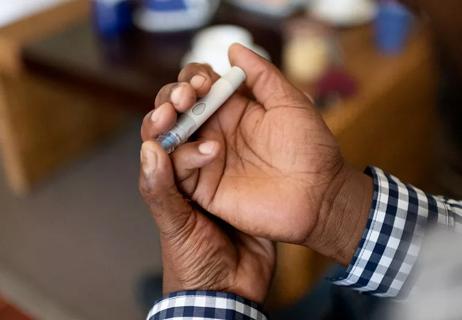How weather can affect your blood sugar

We often look forward to a change of seasons and warmer temperatures. But if you have diabetes, you may be especially sensitive to the hot weather of summer.
Advertisement
Cleveland Clinic is a non-profit academic medical center. Advertising on our site helps support our mission. We do not endorse non-Cleveland Clinic products or services. Policy
Extreme heat can affect your blood sugar control. If you use insulin or your blood sugars aren’t effectively controlled, you could be at higher risk during the summer months. Worsening blood sugar control is often the main concern, and depending on your level of activity, developing low blood sugars may also be a concern.
If you’ve had complications from diabetes that have damaged the nerves to sweat glands, you may be unable to sweat properly. This can become serious as outdoor temperatures rise, leading to heat exhaustion and heat stroke.
Extreme temperatures can also damage your medications and testing equipment, says endocrinologist Marwan Hamaty, MD. “I always remind my patients to take precautions to protect themselves and their supplies during both winter and summer,” he says.
He says it’s important to get a handle on your blood sugar control before you engage in summer fun. “If your blood sugars are mostly higher than 250 mg/dl, I recommend improving your blood sugar control before engaging in heavy physical activity — regardless of the climate and the temperature, as recommended by the American Diabetes Association,” says Dr. Hamaty.
Dr. Hamaty says the extreme heat of summer affects blood sugar levels. How the heat affects your levels depends on what you’ve eaten, whether you’re well-hydrated and your activity level.
Advertisement
If the heat and your activity makes you sweat a lot, you may become dehydrated, leading to a rise in glucose levels. “If you become dehydrated, your blood glucose levels will rise. This can lead to frequent urination, which then leads to further dehydration and even higher blood sugar levels — a kind of vicious cycle,” he says.
Things can become even worse if the treatment includes insulin: “Dehydration reduces blood supply to your skin and, therefore, the ability of your body to absorb the insulin you’ve injected is reduced,” he says.
Most types of insulin can tolerate temperatures up to 93-95 degrees Fahrenheit. Exposing your supply to anything higher than this will make the medication quickly break down. Be careful and pay attention to any insulin you’re carrying with you in the heat.
While it’s fine to store insulin and glucagon in the refrigerator, hot temperatures (as well as freezing temperatures) will cause the medications to degrade, making them ineffective and unusable. High temperatures can have a negative effect on other medications and diabetes management supplies too. Don’t forget about the weather’s effect on things like test strips and monitoring devices. When the mercury begins to rise, these items can change in their effectiveness.
Physical activity usually causes blood sugar levels to decrease, reducing your need for insulin. The sudden addition of exercise may put you at an increased risk for low blood sugars.
Therefore, if you’re active in extreme heat, know that you’re at high risk for both low and high blood sugars. Dr. Hamaty says this means you should take extra precautions and monitor your sugar levels before exercising.
“I advise my patients to maintain warm skin and adjust insulin dosage prior to engaging in physical activity because insulin adjustment could vary significantly,” says Dr. Hamaty.
He also suggests seeking input from your doctor regardless of the temperature before adding physical activity to your routine.
Don’t allow the heat to keep you indoors. Dr. Hamaty says, “I tell my patients they can participate in outdoor activities and enjoy all types of weather as long as they take a few precautions.”
Follow these tips to help manage your diabetes while enjoying the outdoors:
Advertisement
Learn more about our editorial process.
Advertisement

It's important to know your numbers before adjusting meds

With a weakened immune system, every protection counts

Most recommended precautions center around minimizing bruising or swelling

Even one drink can have an impact on your cognitive function leading to slurred speech, blurred vision and impaired memory

Understand who may (and may not) benefit

Lorem ipsum dolor sit amet. Et odio Quis vel ipsam omnis eum alias deleniti et placeat impedit non voluptas galisum hic autem enim et cupiditate aliquid. Est beatae quidem non facilis autem ut commodi nisi aut tempore rerum et dolores voluptatem cum enim optio id sapiente quasi. Ad laboriosam officiis 33 cupiditate sequi ea voluptatum consectetur qui necessitatibus voluptate et quasi doloremque et facere explicabo quo explicabo officia

Type 2 diabetes isn’t inevitable with these dietary changes

Applying a hot or cold compress can help with pain